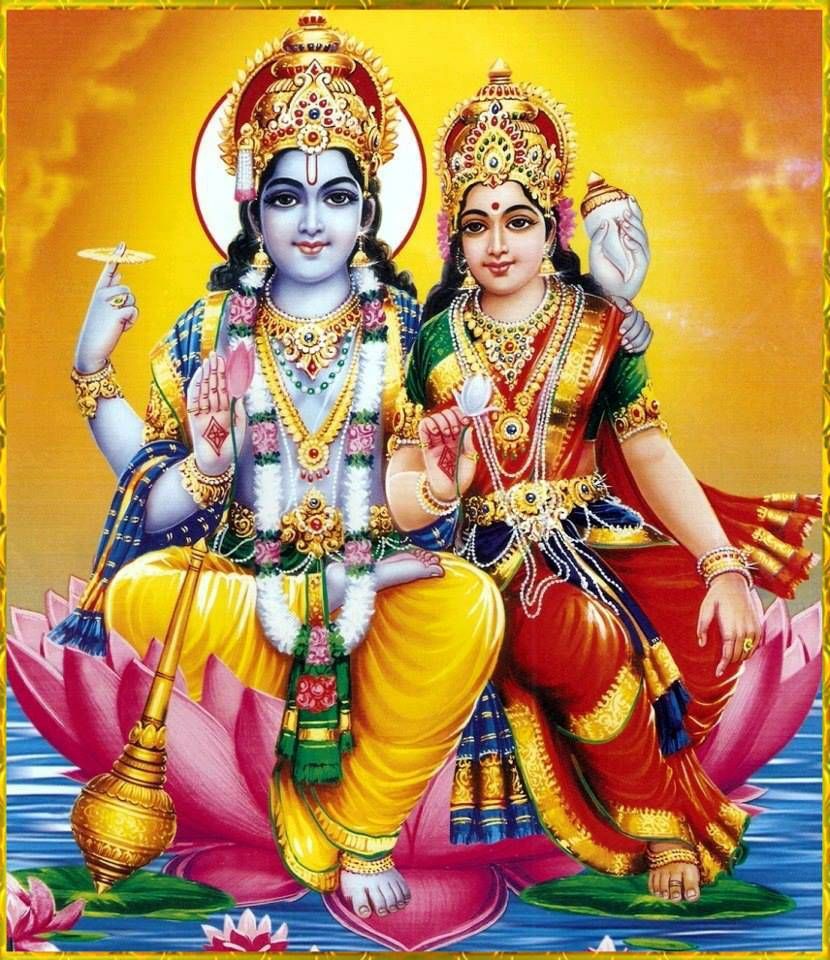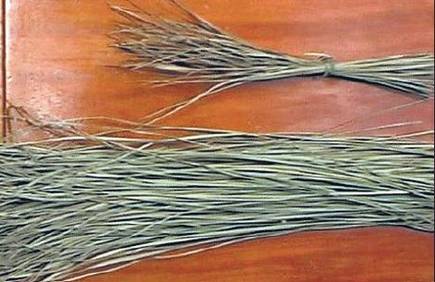Download the Printable document for doing Homam here
Link: Srinivasa Vidya Homam
Srinivasa Vidya is the most sacred, ancient secret system to achieve Aiswaryam (8 types of wealth).
This Vidya was used by Adi Sankaracharya at Tirumala. Further, this Vidya was also used by Hari Hara and Bukka Raya kings to establish Vijayanagara Kingdom from the invading attacks by Mohammadins in the 14th century. We know the fact that in Vijayanagara Kingdom during Srikrishna Devaraya’s reign Diamonds and different stones are sold with vessels in heaps. Once this Srinivasa Vidya is applied in a family it is believed that Goddess Lakshmi will provide wealth to a minimum of 3 generations in that family. Hence, this Vidya can be used for all types of materialistic problems that we might have during human life.
Materials required:
-
One homa kundam as shown in the image (If could not afford any copper vessel can be used by placing 4 bricks below that vessel)
-
Dry Coconut halves
-
Some Jack wood or any sacred wood for burning Homam
-
900 Maredu Samidha (Small sticks of Bilwa tree) for 1-month procedure (30 per day)
-
Some Maredu Patra (Bilwa leaves)- Used for bathing and cooking offerings (Maredu = Aegle marmelos, commonly known as bael, Bengal quince, golden apple, stone apple, wood apple, bili, Bilwa is a species of tree native to India.)
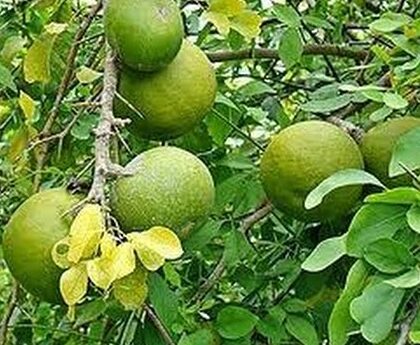
-
Cow Ghee melted
-
Akshatas (Rice mixed with turmeric powder and ghee/water)
-
Match Box
-
Copper/Silver/Earthen Kalasa (Vessel) filled with water
-
Some Water with a tumbler for cleaning hands during Homam
-
Shree Yantra as shown in the image below for doing Archana with Maredu leaves
(One can even print and use the above image also)
-
Some Turmeric Powder
-
Some Vermilion (Kumkum)
-
Some Darbhas (Sacred grass) as shown in the image
(Available with local Indian Pooja store)
-
Agarbathi
-
Camphor (Tablet form-3pieces rest in powder form) – Approximately 50-100grams required to maintain the fire for 1-day Homam when done on a small scale at home
-
Paramannam (Rice to be cooked along with Maredu (Bilwa) leaves, Jaggary, and cow milk) for offering
-
One dried full coconut copra (or) one Dry fruit for Poornahuti per one day
-
An Idol of Lakhsmi Narayana (Optional as you can directly worship Lakshmi Narayana in the fire)
-
Wooden ladle (Spoon)
-
Small earthen or Metal lamp with Gingelly oil (or) Ghee and a cotton wick in it
-
Sandalwood powder/paste
-
Some flowers
-
Agarbathi (Incense Sticks)
-
Cooked Payasam (Rice to be boiled in milk, Jaggary, and Maredu leaves) or fruit or Jaggery or brown sugar (Don’t use normal white sugar as it contains bone ash)
-
Some resins, dry fruits
-
Murmura (Puffed Rice)
-
Havan Samagri (Powder available with Indian Pooja stores)
-
sesame seeds
-
dry coconut pieces
-
2 Metal coins representing Sri Lakshmi Narayana
-
A Small white cloth for Poornahuti
Method
(To be performed only by a Male member of a family)
Procedure:
-
On a Sukla Padyami Day, one need to start this procedure.
-
The mantras required is Sri Suktam + Purusha Suktam + Narayana Kavacham from Rigveda
-
First, 15 mantras of Sri Suktam and Purusha Suktam to be chanted one by one from Sukla Paksha and the first 15 mantras of Purusha Suktam and Sri Suktam to be chanted one by one from Krishna Paksha. At the end of each day Narayana Kavacham to be chanted.
-
900 small dry Maredu Samidha and some leaves. May be available in a local Indian Pooja shop. Purchase some 3Kgs of cow ghee, Camphor powder, Dry Coconut halves, some Jack fruitwood, or any sacred wood for lighting Homam.
-
Strict Brahmacharyam is to be followed during 30 days
-
Starting from a Sukla Padyam day mix Maredu leaves in hot water and one needs to bath before sunrise. Sit before Homa kundam and start the procedure as coined below:
There are 22 steps to be performed in Homam.
-
అనుజ్ఞ (Permission)
-
ఆచమనమం (Sipping water to purify)
-
విఘ్నేశ్వర పూజ (Praying Lord Vigneswara – The Remover of obstacles)
-
ప్రాణాయామం (Restraining the Lifeforce)
-
సంకల్పం (Taking the Vow)
-
కలశ శుద్ధి (Purification of water)
-
అగ్ని ప్రతిస్ఠాపన (Installation of Fire)
-
దిక్పాలక పూజ (Worshipping the Rulers of Directions)
-
పూర్వాంగం (Preliminary offerings)
-
ప్రాణప్రతిష్ఠాపన (Invocation of Deity)
-
పంచోపచార పూజ (5 types of Sevas performed to Deity)
-
గ్రహ ఆహుతి (Offerings to Planets)
-
మూల మంత్రం (Main Mantra)- Where we will recite
-
పునః పూజ (Worshipping one more time)
-
ఉత్తరాంగణం (Vote of Thanks)
-
శుద్ధాన్న బలి (Sacrifice of Pure Rice)
-
వశోర్ధార (Stream of excellence)
-
పూర్ణాహుతి (Poornaahuti)
-
అగ్ని పూజ మరియు ధ్యానం (Final prayer to Agni and Meditation)
-
రక్ష (Raksha)
-
ఉద్వాసన (Goodbye)
-
మంగళం (Conclusion)
Each step was explained in detail below:
1. అనుజ్ఞ (Permission)
Before starting the homam, think in your mind of Mother Earth who is bearing you, Lord Ganesha who removes obstacles, your Ishta devata (favorite deity), your parents, the rishis of your gothra (if you know them), all the rishis, and all your gurus. Then say the following, while mentally requesting all the gods to co-operate with your homam.
ఓం ఋద్ధ్యాస్మ| హవ్యైర్నమ|సోపసద్య|| మిత్రం దేవం మి|త్ర ధేయం| నో అస్తు|
అనూరాధాన్ హవిషా| వర్ధయం|తః|శతం జీవే|మ శరదః సవీ|రాః|
If you have a “pavitram” (a ring made of darbha or a special ring made of metal), wear it now. If you don’t have a pavitram, take any ring that you have, pray to your ishta devata and wear it. It should be worn on the right-hand ring finger. If you don’t have a ring, don’t worry and move on.
2. ఆచమనమం (Sipping water to purify)
Take a little water from the tumbler into your right hand with a spoon. Drink the water after saying the first item below. Take more water with the spoon into your hand, say the second item below, and drink it. Take more water, say the third item below and drink it. Imagine that Vishnu who is within you is getting that water.
ఓం కేశవాయ స్వాహా| ఓం నారాయణాయ స్వాహా| ఓం మాధవాయ స్వాహా|
3. విఘ్నేశ్వర పూజ (Praying Lord Vigneswara – The Remover of obstacles)
శుక్లాంబరధరం విష్ణుం శశివర్ణం చతుర్భుజం| ప్రసన్నవదనం ధ్యాయేత్ సర్వ విఘ్నోపశాంతయే||
అగజానన పద్మార్కం గజాననమహర్నిశం| అనేకదం తం భక్తానాం ఏకదంతం ఉపాస్మహే||
వక్రతుండ మహాకాయ కోటిసూర్యసమప్రభ| నిర్విఘ్నం కురు మే దేవ సర్వకార్యేషు సర్వదా||
4. ప్రాణాయామం (Restraining the Lifeforce)
Take some Akshatas (see “Materials Required” for a description of how to make them) in the left palm, place the left palm on the left lap, hold the nostrils with the right hand and do praanaayaamam. Place the little finger and ring finger on the left nostril and thumb on the right nostril. Close the left nostril, open the right nostril by releasing the thumb and say the mantra below mentally while gently breathing in through the right nostril (without making any breathing sound).
నమో భగవతే వాసుదేవాయ|
After saying the mantra once, close the right nostril with the thumb and say the mantra once more while retaining the air previously breathed in. Then open the left nostril by relaxing the little and ring fingers and say the mantra for the third time while breathing out through the left nostril. When done, say the mantra once more, while breathing in through the left nostril. Then close the left nostril with little and ring fingers and say the mantra for the fifth time while retaining the air previously breathed in. Then release the thumb and say the mantra for the sixth time while breathing out through the right nostril. While reading the mantra all the six times, contemplate the formless supreme Brahman (supreme soul of the entire universe) that fills each being of this universe and also the air being breathed in and out. If you want, you can imagine a specific form (such as your Ishta devata) also and imagine that your Ishta devata fills the entire universe. If you want, you can repeat the above sequence as many times as you comfortably can.
5. సంకల్పం (Taking the Vow)
Now, declare your intention of doing a homam to please Vishnu. Transfer the akshatas to the right hand, place the open left palm (empty) on the right lap, place the closed right palm containing akshatas on the left palm. Then say the following, while mentally thinking that you are going to do a homa to the best of your ability, to please Sri Lakshmi Narayana.
ఓం మమోపాత్త సమస్త దురితక్షయద్వారా శ్రీ పరమేశ్వర ప్రీత్యర్ధం ఐశ్వర్యాభివృద్యర్ధం శ్రీ లక్ష్మీనారాయణ దేవతా అనుగ్రహ సిద్ధ్యర్ధం శ్రీనివాస విద్యామహం కరిష్యే|
Then leave the akshatas from your hand in front of the homa kundam or the idol and sprinkle a little bit of water on the palms. Now light the ghee/oil lamp.
6. కలశ శుద్ధి (Purification of water)
Place a few akshatas and a flower (if available) in the tumbler containing water. If you can, put Dhenu mudra (else, don’t worry). Say the following syllable 11 times to purify the water.
వం
Dhenu Mudra Technique: the left little finger touches the right ring finger, the right little finger – the left ring finger; the left index finger touches the right middle finger, and the right index finger touches the left middle finger. The thumbs are connected.
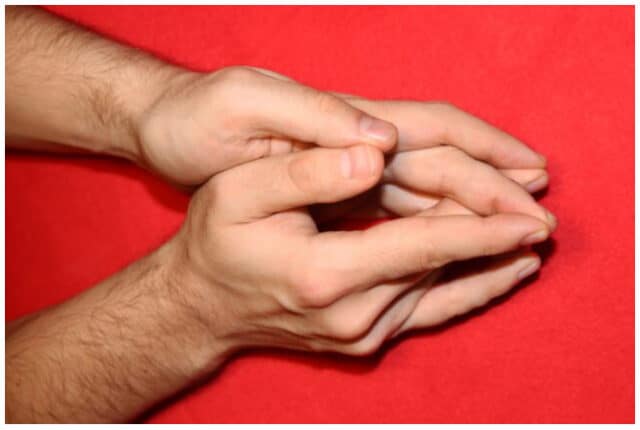
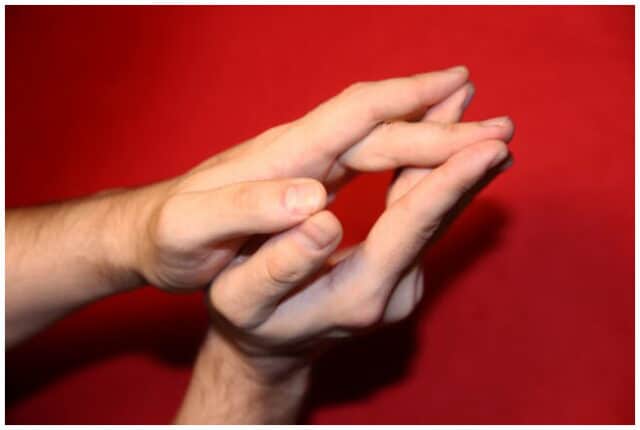
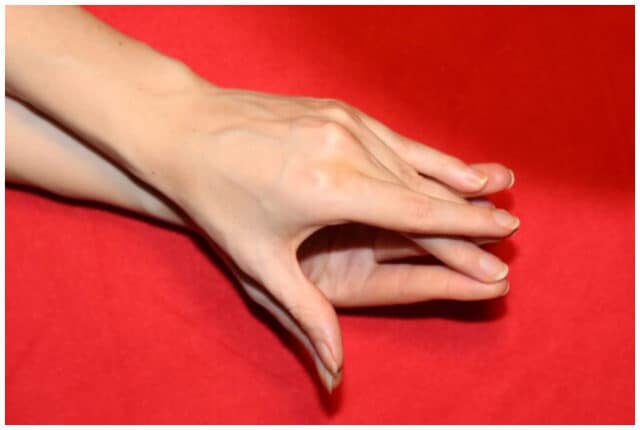
Now read the following and think that auspicious essence of various rivers of the world is entering the water in the tumbler.
గంగే చ యమునే చైవ గోదావరి సరస్వతి |
నర్మదే సింధు కావేరి జలేఽస్మిన్ సన్నిధిం కురు||
అమృతం భవతు
Then take a little water from the tumbler with a flower or flower petal or spoon and sprinkle it on yourself, on homa kundam, on the idol you are going to use and other materials to be used in homam (like fruits, flowers, and food).
Take a darbha (see “Materials Needed” for a description) and draw 6 lines with the darbha on the base of the homakundam, in the same order as shown in Figure. The direction in which each line is drawn is indicated by the direction of the arrow in the figure. Say the following six mantras while drawing the six lines (respectively).
- ఓం బ్రహ్మణే నమః|
- ఓం యమాయ నమః|
- ఓం సోమాయ నమః|
- ఓం రుద్రాయ నమః|
- ఓం విష్ణవే నమః|
- ఓం ఇంద్రాయ నమః|
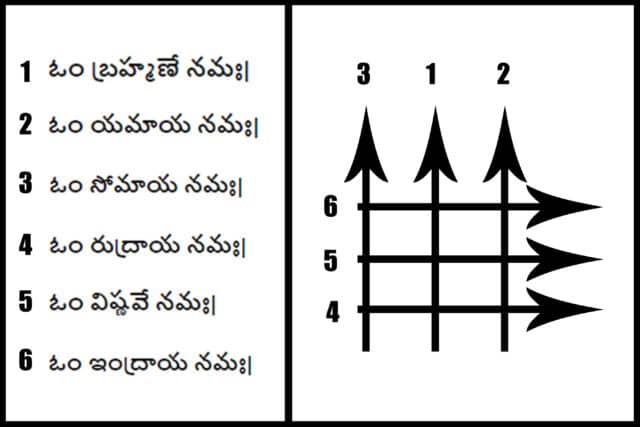
7. అగ్ని ప్రతిస్ఠాపన (Installation of Fire)
Take a darbha. Place it inside the homa kundam (on the base), with the tip of the darbha facing east and the other end facing west. Take another darbha. Place it inside, with the tip of the darbha facing north and the other end facing south. Take a piece of camphor, light it from the lamp and place it in the middle of the homa kundam, while saying:
ఓం భూర్భువస్సువరోమ్|
Place one or more dry coconut pieces (or a log/twig/piece of wood) above the burning camphor and make sure that it catches fire. Next, pray to the fire god using the following mantra from RigVeda. It requests the fire god to keep an inauspicious form of fire called “kravyaada” and carry the offerings to gods through the auspicious form of fire called “jaatavedas”.
క్రవ్యాద|మగ్నిం ప్రహి|ణోమి దూరం యమరా||జ్ఞో గచ్ఛతు రిప్రవాహః|
ఇహైవాయమిత|రో జాతవే||దా దేవేభ్యో|| హవ్యం వ|హతు ప్రజానన్|
Now we have to do samskara (refinement) to the fire. Pour 8 drops of ghee in the fire while saying the following mantra 8 times.
ఓం భూర్భువస్సువః స్వాహా||
Take 2 or more darbhas (or twigs). Place them outside the homa kundam, along the eastern boundary. The tips should be facing north and the other end facing south. Then take another 2 or more darbhas and place them on the southern boundary, with tips facing east and the other end facing west. Then take 2 or more darbhas and place them on the western boundary, with tips facing north. Then take 2 or more darbhas and place them on the northern boundary, with tips facing east. If you do homam on a regular basis, you can leave these darbhas/twigs around the homa kundam there is no need to do this step every time.
Take some water with the spoon and sprinkle it outside the homa kundam, on its four boundaries while reading the following 4 mantras. The order and direction of sprinkling is shown in Figure 2. For example, first sprinkle water from the southwestern corner to the southeastern corner, as shown by the arrow marked “1”. Then follow other arrows marked as 2, 3 and 4.
- అదితేఽను|మస్యస్వ|(SOUTH)
- అను|మతేఽను|మన్యస్వ|(WEST)
- సర|స్వతే ఽను|మన్యస్వ|(NORTH)
- దేవ సవితః ప్రసు|వ|(EAST)
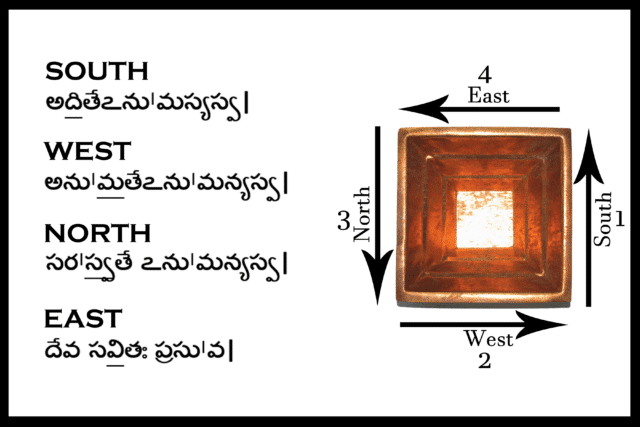
Now pray to Agni (fire god) with the following mantra:
చత్వారి శృంగాస్త్రయో| అస్య పాదాద్వే శీర్షే సప్తహస్తా|సో అస్య|
త్రిధా| బద్ధో వృ|షభో రోర|వీతి మహో దేవో మర్త్యగ్o ఆవివేశ|
ఏష హి దేవః ప్రదిశో ను సర్వాః పూర్వో| హి జాతః స ఉ గర్భే| అంతః|
స విజాయ|మానః స జనిష్యమా|ణః ప్రత్యజ్ముఖా||స్తిష్టతి విశ్వతో|ముఖః|
ప్రాజ్ఞ్ముఖో దేవ| హే అగ్నే| మమాభిముఖో భవ|
Now think within your mind of Lord Ganesha, your Ishta devata (favorite deity), rishis of your gotra (if you know them), all rishis, your gurus, various gods, and other beings of this universe.
8. దిక్పాలక పూజ (Worshipping the Rulers of Directions)
Now, take some akshatas and also some flowers (if available) and offer them to the rulers of directions. Starting with the eastern edge of the homa kundam, go clockwise (i.e. east, southeast, south, southwest etc) and offer akshatas and flowers in the eight directions. You can place them on the edges of the homa kundam. After the eight directions, offerings are made to Brahma (ruler of the upward direction) in the middle of north-east and east and to Sesha (ruler of the downward direction) in the middle of south-west and west. Then offer akshatas and flowers to Agni in the middle of the homa kundam. Finally, touch your heart and offer respect to the self (soul). For the 8+2+1+1=12 offerings, say the following 12 mantras:
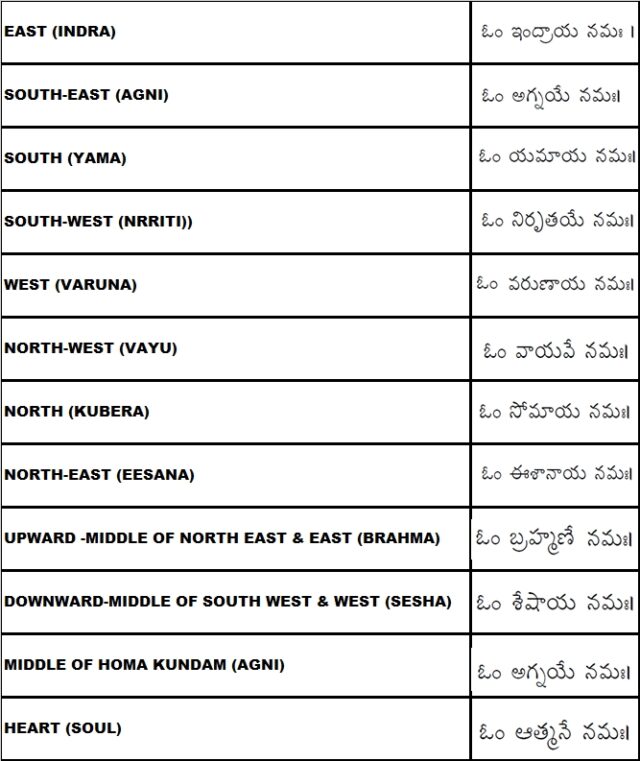
9. పూర్వాంగం (Preliminary offerings)
Now hold the wooden spoon/ladle pointing from north-west towards south-east and offer a ghee drop in the fire for Prajapati (progenitor of all beings), with the following mantra.
ఓం ప్రజాపతయే స్వాహా||| ప్రజాపతయ ఇదం న మమ|
Now hold the wooden spoon/ladle pointing from southwest towards northeast and offer a ghee drop in the fire for Indra (ruler of gods), with the following mantra.
ఓం ఇంద్రాయ స్వాహా||| ఇంద్రాయేదం న మమ|
Offer a little ghee to Agni (fire god) in the middle of the fire with the following mantra:
ఓం అగ్నయే స్వాహా|| |అగ్నయ ఇదం న మమ|
Then offer a little ghee to Soma (god of nourishment and well-being) in the upper half of the northern side of the homa kundam with the following mantra:
ఓం సోమాయ స్వాహా||| సోమాయేదం న మమ|
Pictorial representation of the above procedure:
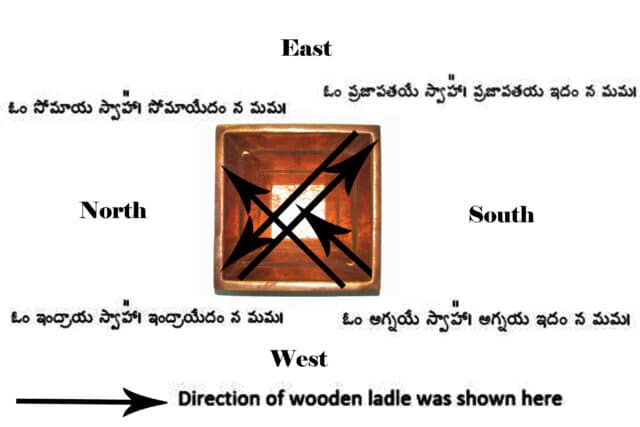
Now, we have to offer a “forgiveness offering” to Prajapati again to request his forgiveness for all the mistakes that happened in the homa up to this point, with the following mantra:
ఆరంభప్రభృతి ఏతత్కషణ పర్యంతం మధ్యే సంభావిత సమస్త దోష ప్రాయశ్చిత్తార్ధం
సర్వ ప్రాయశ్చిత్తం హోష్యామి|
ఓం భుర్భువస్సువః స్వాహా||| ప్రజాపతయ ఇదం న మమ|
After making an offering to the basic gods, as shown above, one can invoke Ganesha in the fire. After the above preliminary offerings and before invoking Ganesha, one can also make offerings to rishis. One can, for example, make offerings to the rishis of one’s lineage. It is optional.
గణపతి హోమం (Ganapathi Homam)
Before calling the main deity of homam (Vishnu) into fire, a quick pooja of Mahaganapathi in fire needs to be done for the removal of obstacles. Mahaganapathi can be invoked in fire while chanting the following.
ఓం గం గణపతయే నమః| ఓం శ్రీ మహగణపతి ప్రాణశక్త్యై నమః |అత్ర ఆగచ్ఛ| ఆవాహితో భవ|
స్థాపితో భవ |సన్నిహితో భవ |సన్నిరుద్ధో భవ |అవకుంఠితో భవ|ప్రసీద ప్రసీద|
Now, we have to offer worship with several services to Mahaganapathi in the fire. Say the following and offer sandalwood powder/paste to Mahaganapathi in the fire. You can also offer turmeric powder and kumkum.
లం పృథివ్యాత్మనే నమః|గంధం సమర్పయామి|
Say the following and offer a flower (or a flower petal) to Mahaganapathi in the fire.
హం ఆకాశాత్మనే నమః|పుష్పం సమర్పయామి|
Say the following and offer dhoopam (incense) to Mahaganapathi in the fire and the idol. Light the tip of the incense stick, let the fire burn brightly and then extinguish the fire. There should be no fire on the stick but smoke coming from the burning tip. Show the smoke to the fire in the homa kundam. You can also offer the incense stick completely into fire.
యం వాయ్వాత్మనే నమః | ధూపం ఆఘ్రాపయామి|
Say the following and show the deepam (light/lamp) to Mahaganapathi in the fire.
రం అగ్న్యాత్మనే నమః |దీపం దర్శయామి|
Say the following and offer some food to Mahaganapathi in the fire. You can use cooked food or fruit or jaggery or brown sugar. Show it to the fire and offer a little bit into the fire. If you cooked only one item, keep it for Vishnu and use something else for Mahaganapathi. You can offer just a raisin or a little brown sugar also.
వం అమృతాత్మనే నమః| నైవేద్యం సమర్పయామి|
Say the following and offer some akshatas to Mahaganapathi in the fire. This mantra means that we are offering “all services” to Him.
సం సర్వాత్మనే నమః| సర్వోపచారాన్ సమర్పయామి|
Now say the following offer ghee (or other allowed materials mentioned at the beginning) into the fire for Mahaganapathi. Repeat that 4 or 8 or 12 times.
ఓం గం గణపతయే నమః|స్వాహా||||
10. ప్రాణప్రతిష్ఠాపన (Invocation of Deity)
Now we have to invoke the deity in the idol and the fire. If you know how to do anganyaasam and karanyaasam, do it while saying the following. Otherwise, just read the following.
అస్య శ్రీ ప్రాణప్రతిష్ఠాపన మంత్రస్య బ్రహ్మ విష్ణు మహేశ్వరా ఋషయః ఋగ్యజుస్సామాథర్వాణి
ఛందాగ్oసి శ్రీ లక్ష్మీనారాయణః దేవతా| హ్రాం బీజం| హ్రీం శక్తిః| క్రోం కీలకం| హ్రాం అంగుష్ఠాభ్యాం నమః|
హ్రీం తర్జనీభ్యాం నమః| హ్రూం మధ్యమాభ్యాం నమః| హ్రైం అనామికాభ్యాం నమః| హ్రౌం కనిష్టికాభ్యాం నమః|
హ్రః కరతల కరపృష్ఠాభ్యాం నమః|హ్రాం హ్రుదయాయ నమః| హ్రీం శిరసే స్వాహా| హ్రూం శిఖాయై వషట్| హ్రైం కవచాయ హుం| హ్రౌం నేత్రత్రయాయ వౌషట్| హ్రః అస్త్రాయ ఫట్| భూర్భువస్సువరోమితి దిగ్బంధః|
Now invoke the deity in the fire and the idol with the following mantra. While saying it, imagine that Lord Vishnu and Goddess Lakshmi who is in your own heart is entering the fire and the idol.
ఓం హ్రాం హ్రీం క్రోం యం రం లం వం శం షం సం హం ళం క్షం| ఓం హంసః సోఽహం సోఽహం హంసః| శ్రీ లక్ష్మీ నారాయణః ప్రాణ ఇహ ప్రాణః| జీవ ఇహ స్థితః| సర్వేంద్రియాణి వాజ్మనశ్చక్షుః శ్రోత్ర జిహ్వాఘ్రాణ ప్రాణాపానవ్యానోదానసమానాః ఇహైవాగత్య సుఖం చిరం తిష్టంతు స్వాహా| సాన్నిధ్యం కుర్వంతు స్వాహా|
అసు|నీ తే పున|రస్మాసు చక్షుః పునః| ప్రాణమిహ నో| దేహి భోగం|| జ్యోక్ప|శ్యేమ సూర్య|ముచ్చరం|తమను|మతే మృళయా| నః స్వస్తి| హ్రాం హ్రీం క్రోం| క్రోం హ్రీం హ్రాం| ఓం శ్రీ లక్ష్మీనారాయణః ప్రాణశక్త్యై నమః| అత్ర ఆగచ్ఛ|
Now read the following Mantras:
ఆవాహితో భవ| స్థాపితో భవ| సన్నిహితో భవ| సన్నిరుద్ధో భవ| అవకుంఠితో భవ| దేవ ప్రసీద ప్రసీద| యావద్ధోమావసానకం| తావత్త్వం ప్రీతిభావేన మూర్తౌ అగ్నౌ చ సన్నిధిం కురు|
While saying this, pray to Lord Vishnu and Goddess Lakshmi in your mind and ask him to stay in the fire and the idol till the end of the homam. Now, till the end of the homam, you should firmly believe that Lord Vishnu and Goddess Lakshmi is in the fire and treat him with respect and love.
11. పంచోపచార పూజ (5 types of Sevas performed to Deities)
Now, we have to offer worship with several services to Lord Vishnu and Goddess Lakshmi in the fire and idol. Say the following and offer sandalwood powder/paste to Vishnu in the fire and the idol. You can also offer turmeric powder and kumkum.
లం పృథివ్యాత్మనే నమః| గంధం సమర్పయామి|
Say the following and offer a flower (or a flower petal) to Vishnu in the fire and the idol.
హం ఆకాశాత్మనే నమః| పుష్పం సమర్పయామి|
Say the following and offer dhoopam (incense) to Vishnu in the fire and the idol. Light the tip of the incense stick, let the fire burn brightly and then extinguish the fire. There should be no fire on the stick but smoke coming from the burning tip. Show the smoke to the fire in the homa kundam.
యం వాయ్వాత్మనే నమః| ధూపం ఆఘ్రాపయామి|
Say the following and show the deepam (light/lamp) to Vishnu in the fire and the idol.
రం అగ్న్యాత్మనే నమః| దీపం దర్శయామి|
Say the following and offer some food to Vishnu in the fire and the idol. You can use cooked food or fruit or jaggery or sugar. Show it to the fire and idol and offer a little bit into the fire. If you made only one food item, it is a good idea to offer it at the end of the homam. There will be a naivedyam (food offering) again. Offer something else for now. The offering at the end is the main one.
వం అమృతాత్మనే నమః| నైవేద్యం సమర్పయామి|
Say the following and offer some Akshatas to Lord Vishnu and Goddess Lakshmi in the fire and the idol. This mantra means that we are offering “all services” to him.
సం సర్వాత్మనే నమః| సర్వోపచారాన్ సమర్పయామి|
12. గ్రహ ఆహుతి (Offerings to Planets)
Planets are equated to Vishnu’s incarnations by Maharshi Parasara. One aahuti of ghee can be made to each planet. This is optional.
ఓం సూర్యాయ స్వాహా|
ఓం చంద్రాయ స్వాహా|
ఓం మంగళాయ స్వాహా|
ఓం బుధాయ స్వాహా|
ఓం బృహస్పతయే స్వాహా|
ఓం శుక్రాయ స్వాహా|
ఓం శనైశ్చరాయ స్వాహా|
ఓం రాహవే స్వాహా|
ఓం కేతవే స్వాహా|
13. మూల మంత్రం (Main Mantra)
With each chanting of the Moola Mantra one Maredu Samidha to be dipped in cow ghee and to be offered in the fire for Lord Vishnu and Goddess Lakshmi. The person who can’t perform the whole procedure of homam can just proceed directly with this moola mantra along with Narayana Kavacham for mediocre results. But great results can be achieved when the Srinivasa Vidya is accompanied by homam as coined in the whole document.
But the right kind of recitation of Veda Mantras is required for results. Hence, I will provide the audio link for recitation soon in the document for each Veda mantra. Meanwhile one may use youtube as a source for learning.
శుక్ల పక్ష ప్రయోగం
(New Moon day to Full Moon day)
హరిః ఓం||
హిర॑ణ్యవర్ణా॒o హరి॑ణీం సు॒వర్ణ॑ రజ॒తస్ర॑జామ్ |
చ॒న్ద్రాం హి॒రణ్మ॑యీం ల॒క్ష్మీం జాత॑వేదో మ॒ ఆవ॑హ||
ఓం స॒హస్ర॑శీర్షా॒ పురు॑షః | స॒హ॒స్రా॒క్షః స॒హస్ర॑పాత్ |
స భూమి॑o వి॒శ్వతో॑ వృ॒త్వా | అత్య॑తిష్ఠద్దశాఙ్గు॒లమ్ ||
తాం మ॒ ఆవ॑హ॒ జాత॑వేదో ల॒క్ష్మీమన॑పగా॒మినీ”మ్ |
యస్యా॒o హిర॑ణ్యం వి॒న్దేయ॒o గామశ్వ॒o పురు॑షాన॒హమ్||
పురు॑ష ఏ॒వేదగ్ం సర్వమ్” | యద్భూ॒తం యచ్చ॒ భవ్యమ్” |
ఉ॒తామృ॑త॒త్వస్యేశా॑నః | య॒దన్నే॑నాతి॒రోహ॑తి ||
అ॒శ్వ॒పూ॒ర్వాం ర॑థమ॒ధ్యాం హ॒స్తినా॑దప్ర॒బోధి॑నీమ్ |
శ్రియ॑o దే॒వీముప॑హ్వయే॒ శ్రీర్మా॑దే॒వీర్జు॑షతామ్||
ఏ॒తావా॑నస్య మహి॒మా |
అతో॒ జ్యాయాగ్॑శ్చ॒ పూరు॑షః|
పాదో”ఽస్య॒ విశ్వా॑ భూ॒తాని॑ | త్రి॒పాద॑స్యా॒మృత॑o ది॒వి ||
కా॒o సో స్మి॒తాం హిర॑ణ్యప్రా॒కారా॑ మా॒ర్ద్రాం జ్వల॑న్తీం తృ॒ప్తాం త॒ర్పయ॑న్తీమ్ |
ప॒ద్మే॒ స్థి॒తాం ప॒ద్మవ॑ర్ణా॒o త్వామి॒హోప॑హ్వయే॒ శ్రియమ్||
త్రి॒పాదూ॒ర్ధ్వ ఉదై॒త్పురు॑షః |
పాదో”ఽస్యే॒హాఽఽ భ॑వా॒త్పున॑: |
తతో॒ విష్వ॒ఙ్వ్య॑క్రామత్ |
సా॒శ॒నా॒న॒శ॒నే అ॒భి ||
చన్ద్రాం ప్ర॑భా॒సాం య॒శసా॒ జ్వల॑న్తీ॒o శ్రియ॑o లో॒కే దే॒వజు॑ష్టాముదా॒రామ్ |
తాం ప॒ద్మినీ॑మీ॒o శర॑ణమ॒హం ప్రప॑ద్యేఽల॒క్ష్మీర్మే॑ నశ్యతా॒o త్వాం వృ॑ణే||
తస్మా”ద్వి॒రాడ॑జాయత |
వి॒రాజో॒ అధి॒ పూరు॑షః | సజా॒తో అత్య॑రిచ్యత |
ప॒శ్చాద్భూమి॒ మథో॑ పు॒రః ||
ఆ॒ది॒త్యవ॑ర్ణే॒ తప॒సోఽధి॑జా॒తో వన॒స్పతి॒స్తవ॑ వృ॒క్షోఽథ బి॒ల్వః |
తస్య॒ ఫలా॑ని॒ తప॒సాను॑దన్తు మా॒యాన్త॑రా॒యాశ్చ॑ బా॒హ్యా అ॑ల॒క్ష్మీః||
యత్పురు॑షేణ హ॒విషా” | దే॒వా య॒జ్ఞమత॑న్వత |
వ॒స॒న్తో అ॑స్యా సీ॒దాజ్యమ్” | గ్రీ॒ష్మ ఇ॒ధ్మ శ్శ॒రద్ధ॒విః ||
ఉపై॑తు॒ మాం దే॑వస॒ఖః కీ॒ర్తిశ్చ॒ మణి॑నా స॒హ |
ప్రా॒దు॒ర్భూ॒తోఽస్మి॑ రాష్ట్రే॒ఽస్మిన్ కీ॒ర్తిమృ॑ద్ధిం ద॒దాతు॑ మే||
స॒ప్తాస్యా॑సన్పరి॒ధయ॑: | త్రిః స॒ప్త స॒మిధ॑: కృ॒తాః |
దే॒వా యద్య॒జ్ఞం త॑న్వా॒నాః |
అబ॑ధ్న॒న్పురు॑షం ప॒శుమ్ ||
క్షుత్పి॑పా॒సామ॑లాం జ్యే॒ష్ఠామ॑ల॒క్ష్మీం నా॑శయా॒మ్యహమ్ |
అభూ॑తి॒మస॑ మృద్ధి॒oచ సర్వా॒o నిర్ణు॑ద మే॒ గృహా॑త్||
తం య॒జ్ఞం బ॒ర్హిషి॒ ప్రౌక్షన్॑ |
పురు॑షం జా॒తమ॑గ్ర॒తః |
తేన॑ దే॒వా అయ॑జన్త | సా॒ధ్యా ఋష॑యశ్చ॒యే ||
గ॒oధ॒ద్వా॒రాం దు॑రాధ॒ర్షా॒o ని॒త్యపు॑ష్టాం కరీ॒షిణీ”మ్ |
ఈ॒శ్వరీ॑గ్ం సర్వ॑భూతా॒నా॒o త్వామి॒హోప॑హ్వయే॒ శ్రియమ్||
తస్మా”ద్య॒జ్ఞాత్స॑ర్వ॒హుత॑: | సంభృ॑తం పృషదా॒జ్యమ్ |
ప॒శూగ్స్తాగ్శ్చ॑క్రే వాయ॒వ్యాన్॑ | ఆ॒ర॒ణ్యాన్గ్రా॒మ్యాశ్చ॒ యే ||
మన॑స॒: కామ॒మాకూ॑తిం వా॒చఃస॒త్యమ॑శీమహి |
ప॒శూ॒నాం రూ॒పమన్న॑స్య॒ మయి॒శ్రీఃశ్ర॑యతా॒o యశ॑:||
తస్మా”ద్య॒జ్ఞాత్స॑ర్వ॒హుత॑: | ఋచ: సామా॑ని జజ్ఞిరే |
ఛన్దాగ్॑oసిజజ్ఞిరే॒ తస్మా”త్ | యజు॒స్తస్మా॑ద జాయత ||
క॒ర్దమే॑న ప్ర॑జాభూ॒తా॒ మ॒యి॒సంభ॑వ క॒ర్దమ |
శ్రియ॑o వా॒సయ॑మేకు॒లే మా॒తర॑oపద్మ॒మాలి॑నీమ్||
తస్మా॒దశ్వా॑ అజాయన్త | యేకేచో॑ భ॒యాద॑తః |
గావో॑హజజ్ఞిరే॒ తస్మా”త్ | తస్మా”జ్జా॒తా అ॑జా॒వయ॑: ||
ఆప॑: సృ॒జన్తు॑ స్ని॒గ్ధా॒ని॒ చి॒క్లీ॒త వ॑స మే॒ గృహే |
ని చ॑ దే॒వీం మా॒తర॒గ్o శ్రియ॑o వా॒సయ॑ మే కు॒లే||
యత్పురు॑ష॒o వ్య॑దధుః | క॒తి॒ధా వ్య॑కల్పయన్ |
ముఖ॒oకిమ॑స్య॒ కౌ బా॒హూ | కావూ॒రూ పాదా॑ వుచ్యేతే ||
ఆ॒ర్ద్రాం పు॒ష్కరి॑ణీం పు॒ష్టి॒o సు॒వ॒ర్ణాం హే॑మమా॒లినీమ్ |
సూ॒ర్యాం హి॒రణ్మ॑యీం ల॒క్ష్మీ॒o జాత॑వేదో మ॒ ఆవహ||
బ్రా॒హ్మ॒ణో”ఽస్య॒ ముఖ॑మాసీత్ | బా॒హూ రా॑జ॒న్య॑: కృ॒తః |
ఊ॒రూ తద॑స్య॒ యద్వైశ్య॑: | ప॒ద్భ్యాగ్ం శూ॒ద్రో అ॑జాయత ||
ఆ॒ర్ద్రాం య॒: కరి॑ణీం య॒ష్టి॒o పి॒ఙ్గ॒లాం ప॑ద్మమా॒లినీమ్|
చ॒న్ద్రాం హి॒రణ్మ॑యీం ల॒క్ష్మీం జాత॑వేదో మ॒ ఆవ॑హ||
చ॒న్ద్రమా॒ మన॑సో జా॒తః | చక్షో॒:సూర్యో॑ అజాయత |
ముఖా॒దిన్ద్ర॑శ్చా॒గ్నిశ్చ॑ | ప్రా॒ణాద్వా॒యుర॑జాయత ||
తాం మ॒ ఆవ॑హ॒ జాత॑వేదో ల॒క్ష్మీమన॑పగా॒మినీ”మ్ |
యస్యా॒o హి॑రణ్య॒o ప్రభూ॑త॒o గావో॑ దా॒స్యోఽశ్వా”న్వి॒న్దేయ॒o పురు॑షాన॒హమ్||
నాభ్యా॑ఆసీద॒న్తరి॑క్షమ్ | శీ॒ర్ష్ణోద్యౌః సమ॑వర్తత |
ప॒ద్భ్యాంభూమి॒ ర్దిశ॒:శ్రోత్రా”త్ |
తథా॑ లో॒కాగ్ం అ॑కల్పయన్||
కృష్ణ పక్ష ప్రయోగం
(Next day after Full Moon day to No Moon day)
ఓం స॒హస్ర॑శీర్షా॒ పురు॑షః | స॒హ॒స్రా॒క్షః స॒హస్ర॑పాత్ |
స భూమి॑o వి॒శ్వతో॑ వృ॒త్వా | అత్య॑తిష్ఠద్దశాఙ్గు॒లమ్ ||
హిర॑ణ్యవర్ణా॒o హరి॑ణీం సు॒వర్ణ॑ రజ॒తస్ర॑జామ్ |
చ॒న్ద్రాం హి॒రణ్మ॑యీం ల॒క్ష్మీం జాత॑వేదో మ॒ ఆవ॑హ||
పురు॑ష ఏ॒వేదగ్ం సర్వమ్” | యద్భూ॒తం యచ్చ॒ భవ్యమ్” |
ఉ॒తామృ॑త॒త్వస్యేశా॑నః | య॒దన్నే॑నాతి॒రోహ॑తి ||
తాం మ॒ ఆవ॑హ॒ జాత॑వేదో ల॒క్ష్మీమన॑పగా॒మినీ”మ్ |
యస్యా॒o హిర॑ణ్యం వి॒న్దేయ॒o గామశ్వ॒o పురు॑షాన॒హమ్||
ఏ॒తావా॑నస్య మహి॒మా |
అతో॒ జ్యాయాగ్॑శ్చ॒ పూరు॑షః|
పాదో”ఽస్య॒ విశ్వా॑ భూ॒తాని॑ | త్రి॒పాద॑స్యా॒మృత॑o ది॒వి ||
అ॒శ్వ॒పూ॒ర్వాం ర॑థమ॒ధ్యాం హ॒స్తినా॑దప్ర॒బోధి॑నీమ్ |
శ్రియ॑o దే॒వీముప॑హ్వయే॒ శ్రీర్మా॑దే॒వీర్జు॑షతామ్||
త్రి॒పాదూ॒ర్ధ్వ ఉదై॒త్పురు॑షః |
పాదో”ఽస్యే॒హాఽఽ భ॑వా॒త్పున॑: |
తతో॒ విష్వ॒ఙ్వ్య॑క్రామత్ |
సా॒శ॒నా॒న॒శ॒నే అ॒భి ||
కా॒o సో స్మి॒తాం హిర॑ణ్యప్రా॒కారా॑ మా॒ర్ద్రాం జ్వల॑న్తీం తృ॒ప్తాం త॒ర్పయ॑న్తీమ్ |
ప॒ద్మే॒ స్థి॒తాం ప॒ద్మవ॑ర్ణా॒o త్వామి॒హోప॑హ్వయే॒ శ్రియమ్||
తస్మా”ద్వి॒రాడ॑జాయత |
వి॒రాజో॒ అధి॒ పూరు॑షః | సజా॒తో అత్య॑రిచ్యత |
ప॒శ్చాద్భూమి॒ మథో॑ పు॒రః ||
చన్ద్రాం ప్ర॑భా॒సాం య॒శసా॒ జ్వల॑న్తీ॒o శ్రియ॑o లో॒కే దే॒వజు॑ష్టాముదా॒రామ్ |
తాం ప॒ద్మినీ॑మీ॒o శర॑ణమ॒హం ప్రప॑ద్యేఽల॒క్ష్మీర్మే॑ నశ్యతా॒o త్వాం వృ॑ణే||
యత్పురు॑షేణ హ॒విషా” | దే॒వా య॒జ్ఞమత॑న్వత |
వ॒స॒న్తో అ॑స్యా సీ॒దాజ్యమ్” | గ్రీ॒ష్మ ఇ॒ధ్మ శ్శ॒రద్ధ॒విః ||
ఆ॒ది॒త్యవ॑ర్ణే॒ తప॒సోఽధి॑జా॒తో వన॒స్పతి॒స్తవ॑ వృ॒క్షోఽథ బి॒ల్వః |
తస్య॒ ఫలా॑ని॒ తప॒సాను॑దన్తు మా॒యాన్త॑రా॒యాశ్చ॑ బా॒హ్యా అ॑ల॒క్ష్మీః||
స॒ప్తాస్యా॑సన్పరి॒ధయ॑: | త్రిః స॒ప్త స॒మిధ॑: కృ॒తాః |
దే॒వా యద్య॒జ్ఞం త॑న్వా॒నాః |
అబ॑ధ్న॒న్పురు॑షం ప॒శుమ్ ||
ఉపై॑తు॒ మాం దే॑వస॒ఖః కీ॒ర్తిశ్చ॒ మణి॑నా స॒హ |
ప్రా॒దు॒ర్భూ॒తోఽస్మి॑ రాష్ట్రే॒ఽస్మిన్ కీ॒ర్తిమృ॑ద్ధిం ద॒దాతు॑ మే||
తం య॒జ్ఞం బ॒ర్హిషి॒ ప్రౌక్షన్॑ |
పురు॑షం జా॒తమ॑గ్ర॒తః |
తేన॑ దే॒వా అయ॑జన్త | సా॒ధ్యా ఋష॑యశ్చ॒యే ||
క్షుత్పి॑పా॒సామ॑లాం జ్యే॒ష్ఠామ॑ల॒క్ష్మీం నా॑శయా॒మ్యహమ్ |
అభూ॑తి॒మస॑ మృద్ధి॒oచ సర్వా॒o నిర్ణు॑ద మే॒ గృహా॑త్||
తస్మా”ద్య॒జ్ఞాత్స॑ర్వ॒హుత॑: | సంభృ॑తం పృషదా॒జ్యమ్ |
ప॒శూగ్స్తాగ్శ్చ॑క్రే వాయ॒వ్యాన్॑ | ఆ॒ర॒ణ్యాన్గ్రా॒మ్యాశ్చ॒ యే ||
గ॒oధ॒ద్వా॒రాం దు॑రాధ॒ర్షా॒o ని॒త్యపు॑ష్టాం కరీ॒షిణీ”మ్ |
ఈ॒శ్వరీ॑గ్ం సర్వ॑భూతా॒నా॒o త్వామి॒హోప॑హ్వయే॒ శ్రియమ్||
తస్మా”ద్య॒జ్ఞాత్స॑ర్వ॒హుత॑: | ఋచ: సామా॑ని జజ్ఞిరే |
ఛన్దాగ్॑oసిజజ్ఞిరే॒ తస్మా”త్ | యజు॒స్తస్మా॑ద జాయత ||
మన॑స॒: కామ॒మాకూ॑తిం వా॒చఃస॒త్యమ॑శీమహి |
ప॒శూ॒నాం రూ॒పమన్న॑స్య॒ మయి॒శ్రీఃశ్ర॑యతా॒o యశ॑:||
తస్మా॒దశ్వా॑ అజాయన్త | యేకేచో॑ భ॒యాద॑తః |
గావో॑హజజ్ఞిరే॒ తస్మా”త్ | తస్మా”జ్జా॒తా అ॑జా॒వయ॑: ||
క॒ర్దమే॑న ప్ర॑జాభూ॒తా॒ మ॒యి॒సంభ॑వ క॒ర్దమ |
శ్రియ॑o వా॒సయ॑మేకు॒లే మా॒తర॑oపద్మ॒మాలి॑నీమ్||
యత్పురు॑ష॒o వ్య॑దధుః | క॒తి॒ధా వ్య॑కల్పయన్ |
ముఖ॒oకిమ॑స్య॒ కౌ బా॒హూ | కావూ॒రూ పాదా॑ వుచ్యేతే ||
ఆప॑: సృ॒జన్తు॑ స్ని॒గ్ధా॒ని॒ చి॒క్లీ॒త వ॑స మే॒ గృహే |
ని చ॑ దే॒వీం మా॒తర॒గ్o శ్రియ॑o వా॒సయ॑ మే కు॒లే||
బ్రా॒హ్మ॒ణో”ఽస్య॒ ముఖ॑మాసీత్ | బా॒హూ రా॑జ॒న్య॑: కృ॒తః |
ఊ॒రూ తద॑స్య॒ యద్వైశ్య॑: | ప॒ద్భ్యాగ్ం శూ॒ద్రో అ॑జాయత ||
ఆ॒ర్ద్రాం పు॒ష్కరి॑ణీం పు॒ష్టి॒o సు॒వ॒ర్ణాం హే॑మమా॒లినీమ్ |
సూ॒ర్యాం హి॒రణ్మ॑యీం ల॒క్ష్మీ॒o జాత॑వేదో మ॒ ఆవహ||
చ॒న్ద్రమా॒ మన॑సో జా॒తః | చక్షో॒:సూర్యో॑ అజాయత |
ముఖా॒దిన్ద్ర॑శ్చా॒గ్నిశ్చ॑ | ప్రా॒ణాద్వా॒యుర॑జాయత ||
ఆ॒ర్ద్రాం య॒: కరి॑ణీం య॒ష్టి॒o పి॒ఙ్గ॒లాం ప॑ద్మమా॒లినీమ్|
చ॒న్ద్రాం హి॒రణ్మ॑యీం ల॒క్ష్మీం జాత॑వేదో మ॒ ఆవ॑హ||
నాభ్యా॑ఆసీద॒న్తరి॑క్షమ్ | శీ॒ర్ష్ణోద్యౌః సమ॑వర్తత |
ప॒ద్భ్యాంభూమి॒ ర్దిశ॒:శ్రోత్రా”త్ |
తథా॑ లో॒కాగ్ం అ॑కల్పయన్||
తాం మ॒ ఆవ॑హ॒ జాత॑వేదో ల॒క్ష్మీమన॑పగా॒మినీ”మ్ |
యస్యా॒o హి॑రణ్య॒o ప్రభూ॑త॒o గావో॑ దా॒స్యోఽశ్వా”న్వి॒న్దేయ॒o పురు॑షాన॒హమ్||
నారాయణ కవచం (Narayana Kavacham)
(To be read after every day after reading the moola mantra)
రాజోవాచ |
యేన గుప్తః సహస్రాక్షః సవాహానరిసైనికాన్ |
క్రీడన్నివ వినిర్జిత్య త్రిలోక్యం బుభుజే శ్రియమ్ || 1 ||
భగవంస్తన్మమాఖ్యాహి వర్మ నారాయణాత్మకమ్ |
యథాఽఽతతాయినః శత్రూన్ యేన గుప్తోఽజయన్మృధే || 2 ||
శ్రీ శుక ఉవాచ |
వృతః పురోహితస్త్వాష్ట్రో మహేన్ద్రాయానుపృచ్ఛతే |
నారాయణాఖ్యం వర్మాహం తదిహైకమనాః శృణు || 3 ||
శ్రీ విశ్వరూప ఉవాచ |
ధౌతాంఘ్రిపాణిరాచమ్య సపవిత్ర ఉదఙ్ముఖః |
కృతస్వాంగకరన్యాసో మన్త్రాభ్యాం వాగ్యతః శుచిః || 4 ||
నారాయణమయం వర్మ సన్నహ్యేద్భయ ఆగతే |
పాదయోర్జానునోరూర్వోరుదరే హృద్యథోరసి || 5 ||
ముఖే శిరస్యానుపూర్వ్యాదోంకారాదీని విన్యసేత్ |
ఓం నమో నారాయణాయేతి విపర్యయమథాపి వా || 6 ||
కరన్యాసం తతః కుర్యాద్ద్వాదశాక్షరవిద్యయా |
ప్రణవాదియకారాన్తమంగుల్యంగుష్ఠపర్వసు || 7 ||
న్యసేద్ధృదయ ఓంకారం వికారమను మూర్ధని |
షకారం తు భ్రువోర్మధ్యే ణకారం శిఖయా న్యశేత్ || 8 ||
వేకారం నేత్రయోర్యుంజ్యాన్నకారం సర్వసంధిషు |
మకారమస్త్రముద్దిశ్య మన్త్రమూర్తిర్భవేద్బుధః || 9 ||
సవిసర్గం ఫడన్తం తత్ సర్వదిక్షు వినిర్దిశేత్ |
ఓం విష్ణవే నమః || 10 ||
ఇత్యాత్మానం పరం ధ్యాయేద్ధ్యేయం షట్ఛక్తిభిర్యుతమ్ |
విద్యాతేజస్తపోమూర్తి మిమం మన్త్రముదాహరేత్ || 11 ||
ఓం హరిర్విదధ్యాన్మమ సర్వరక్షాం
న్యస్తాంఘ్రిపద్మః పతగేంద్రపృష్ఠే |
దరారిచర్మాసిగదేషుచాప-
పాశాందధానోఽష్టగుణోఽష్టబాహుః || 12 ||
జలేషు మాం రక్షతు మత్స్యమూర్తి-
ర్యాదోగణేభ్యో వరుణస్య పాశాత్ |
స్థలేషు మాయావటువామనోఽవ్యాత్
త్రివిక్రమః సోఽవతు విశ్వరూపః || 13 ||
దుర్గేష్వటవ్యాజిముఖాదిషు ప్రభుః
పాయాన్నృసింహోఽసురయూథపారిః |
విముంచతో యస్య మహాట్టహాసం
దిశో వినేదుర్న్యపతంశ్చ గర్భాః || 14 ||
రక్షత్వసౌ మే ధ్వని యజ్ఞకల్పః
స్వదంష్ట్రయోన్నీతధరో వరాహః |
రామోఽద్రికూటేష్వథ విప్రవాసే
సలక్ష్మణోఽవ్యాద్భరతాగ్రజోమామ్ || 15 ||
మాముగ్రధర్మాదఖిలాత్ప్రమాదా-
న్నారాయణః పాతు నరశ్చ హాసాత్ |
దత్తస్త్వయోగాదథ యోగనాథః
పాయాద్గుణేశః కపిలః కర్మబంధాత్ || 16 ||
సనత్కుమారోఽవతు కామదేవాత్
హయాననో మాం పథి దేవహేలనాత్ |
దేవర్షివర్యః పురుషార్చనాంతరాత్
కూర్మో హరిర్మాం నిరయాదశేషాత్ || 17 ||
ధన్వంతరిర్భగవాన్పాత్వపథ్యా-
ద్ద్వంద్వాద్భయాదృషభో నిర్జితాత్మా |
యజ్ఞశ్చ లోకాదవతాజ్జనాంతా-
ద్బలో గణాత్క్రోధవశాదహీంద్రః || 18 ||
ద్వైపాయనో భగవానప్రబోధా-
ద్బుద్ధస్తు పాషండగణాత్ప్రమాదాత్ |
కల్కిః కలేః కాలమలాత్ప్రపాతు
ధర్మావనాయోరుకృతావతారః || 19 ||
మాం కేశవో గదయా ప్రాతరవ్యా-
ద్గోవింద ఆసంగవమాత్తవేణుః |
నారాయణః ప్రాహ్ణ ఉదాత్తశక్తి-
ర్మధ్యందినే విష్ణురరీంద్రపాణిః || 20 ||
దేవోఽపరాహ్ణే మధుహోగ్రధన్వా
సాయం త్రిధామావతు మాధవో మామ్ |
దోషే హృషీకేశ ఉతార్ధరాత్రే
నిశీథ ఏకోఽవతు పద్మనాభః || 21 ||
శ్రీవత్సధామాపరరాత్ర ఈశః
ప్రత్యుష ఈశోఽసిధరో జనార్దనః |
దామోదరోఽవ్యాదనుసంధ్యం ప్రభాతే
విశ్వేశ్వరో భగవాన్ కాలమూర్తిః || 22 ||
చక్రం యుగాంతానలతిగ్మనేమి
భ్రమత్సమంతాద్భగవత్ప్రయుక్తమ్ |
దందగ్ధి దందగ్ధ్యరిసైన్యమాశు
కక్షం యథా వాతసఖో హుతాశః || 23 ||
గదేఽశనిస్పర్శనవిస్ఫులింగే
నిష్పింఢి నిష్పింఢ్యజితప్రియాసి |
కూష్మాండవైనాయకయక్షరక్షో-
భూతగ్రహాంశ్చూర్ణయ చూర్ణయారీన్ || 24 ||
త్వం యాతుధానప్రమథప్రేతమాతృ-
పిశాచవిప్రగ్రహఘోరదృష్టీన్ |
దరేంద్ర విద్రావయ కృష్ణపూరితో
భీమస్వనోఽరేర్హృదయాని కంపయన్ || 25 ||
త్వం తిగ్మధారాసివరారిసైన్య-
మీశప్రయుక్తో మమ ఛింధి ఛింధి |
చక్షూంషి చర్మన్ శతచంద్ర ఛాదయ
ద్విషామఘోనాం హర పాపచక్షుషామ్ || 26 ||
యన్నో భయం గ్రహేభ్యోఽభూత్కేతుభ్యో నృభ్య ఏవ చ |
సరీసృపేభ్యో దంష్ట్రిభ్యో భూతేభ్యోఘేభ్య ఏవ చ || 27 ||
సర్వాణ్యేతాని భగవన్నామరూపాస్త్రకీర్తనాత్ |
ప్రయాంతు సంక్షయం సద్యో యే మే శ్రేయఃప్రతీపకాః || 28 ||
గరుడో భగవాన్ స్తోత్రస్తోభశ్ఛందోమయః ప్రభుః |
రక్షత్వశేషకృచ్ఛ్రేభ్యో విష్వక్సేనస్య వాహనమ్ || 29 ||
సర్వాపద్భ్యో హరేర్నామరూపయానాయుధాని నః |
బుద్ధీంద్రియమనఃప్రాణాన్పాంతు పార్షదభూషణాః || 30 ||
యథా హి భగవానేవ వస్తుతః సదసచ్చ యత్ |
సత్యేనానేన నః సర్వే యాంతు నాశముపద్రవాః || 31 ||
యథైకాత్మ్యానుభావానాం వికల్పరహితః స్వయమ్ |
భూషణాయుధలింగాఖ్యా ధత్తే శక్తీః స్వమాయయా || 32 ||
తేనైవ సత్యమానేన సర్వజ్ఞో భగవాన్ హరిః |
పాతు సర్వైః స్వరూపైర్నః సదా సర్వత్ర సర్వగః || 33 ||
విదిక్షు దిక్షూర్ధ్వమధః సమంతా-
దంతర్బహిర్భగవాన్నారసింహః |
ప్రహాపయన్ లోకభయం స్వనేన
స్వతేజసా గ్రస్తసమస్తతేజాః || 34 ||
మఘవన్నిదమాఖ్యాతం వర్మ నారాయణాత్మకమ్ |
విజేష్యస్యంజసా యేన దంశితోఽసురయూథపాన్ || 35 ||
ఏతద్ధారయమాణస్తు యం యం పశ్యతి చక్షుషా |
పదా వా సంస్పృశేత్సద్యః సాధ్వసాత్స విముచ్యతే || 36 ||
న కుతశ్చిద్భయం తస్య విద్యాం ధారయతో భవేత్ |
రాజదస్యుగ్రహాదిభ్యో వ్యాఘ్రాదిభ్యశ్చ కర్హిచిత్ || 37 ||
ఇమాం విద్యాం పురా కశ్చిత్కౌశికో ధారయన్ ద్విజః |
యోగధారణయా స్వాంగం జహౌ స మరుధన్వని || 38 ||
తస్యోపరి విమానేన గంధర్వపతిరేకదా |
యయౌ చిత్రరథః స్త్రీభిర్వృతో యత్ర ద్విజక్షయః || 39 ||
గగనాన్న్యపతత్సద్యః సవిమానో హ్యవాక్షిరాః |
స వాలఖిల్యవచనాదస్థీన్యాదాయ విస్మితః |
ప్రాప్య ప్రాచ్యాం సరస్వత్యాం స్నాత్వా ధామ స్వమన్వగాత్ || 40 ||
య ఇదం శృణుయాత్కాలే యో ధారయతి చాదృతః |
తం నమస్యంతి భూతాని ముచ్యతే సర్వతో భయాత్ || 41 ||
శ్రీశుక ఉవాచ |
ఏతాం విద్యామధిగతో విశ్వరూపాచ్ఛతక్రతుః |
త్రైలోక్యలక్ష్మీం బుభుజే వినిర్జిత్య మృధేఽసురాన్ || 42 ||
ఇతి శ్రీ నారాయణ కవచం ||
When making the last offering with a mantra say the following Vedic Syllabi.
వౌషట్ (Say this word after finishing all 30 Maredu (Bilwa) Ahutis for one day)
The offering can be a drop of ghee or sesame seeds or murmura (puffed white rice) or havan samagri or small dry coconut pieces or small pieces of darbha. If you are doing homam on a big scale with a big fire, you can even put banana slices, full coconuts, various fruits, nuts (cashews, almonds etc), dates, raisins, sugar cane pieces, several sweets, and snacks etc. But, if you are doing on a small scale with a small fire, stick to sesame seeds, dry coconut pieces, puffed white rice, and ghee drops. At any cost, avoid spicy substances like any kind of pepper, cinnamon, cloves etc and products containing eggs, meat etc. In general, sweet substances are better. Just offering ghee when you do not have any other substances is also fine.
14. పునః పూజ (Worshipping one more time)
After all the offerings with mantras, we offer quick worship again to Lord Vishnu and Goddess Lakshmi in the fire. Say the following and offer some food to both in the fire and the idols.
ఓం లక్ష్మీనారాయణే నమః| నైవేద్యం సమర్పయామి|
Light a small camphor piece in a plate and show it to the fire while saying the following. In the end, you can throw the camphor piece into fire.
ఓం లక్ష్మీనారాయణే నమః| నీరాజనం సమర్పయామి|
If one has time, a panchopachara pooja can also be done as the punah pooja. But the above two things will suffice.
15. ఉత్తరాంగణం (Vote of Thanks)
Now, offer one drop of ghee to Prajapati, then the controllers of the three worlds (bhuh – fire god, bhuvah – wind god, who controls space too, suvah – sun god for all the non-material spiritual realms), to Agni who processes the food for gods and makes it consumable and finally Prajapati again. Read the following and offer a drop of ghee at each “swaahaa”.
ఓం ప్రజా|పతే న త్వదేతాన్యన్యో విశ్వా| జాతాని పరి తా బ|భూవ| యత్కా|మాస్తే జుహుమస్తన్నో| అస్తు
వ|యగ్ం స్యా|మ పత|యో రయీణామ్| స్వాహా||| ప్రజాపతయ ఇదం న మమ||
ఓం భూః స్వాహా||| అగ్నయ ఇదం న మమ||
ఓం భువః స్వాహా||| వాయవ ఇదం న మమ||
ఓం సువః స్వాహా||| సుర్యాయ ఇదం న మమ||
యద|స్య కర్మణోఽత్యరీ|రిచం యద్వాన్యూ|నమిహాక|రమ్| అగ్నిష్టత్ స్విష్టకృద్విద్వాన్ సర్వం స్వి|ష్టం సుహు|తం కరోతు స్వాహా| అగ్నయే స్విష్టకృత ఇదం న మమ||
ఓం భూర్భువస్సువః స్వాహా|| ప్రజాపతయ ఇదం న మమ||
Now do pranaayaamam again. The procedure of pranaayaamam is explained earlier. Now, make three offerings to the fire god, asking for forgiveness for any mistakes committed knowingly or unknowingly, while using fire as the medium. Read the following and offer a drop of the ghee in the fire at each “swaahaa”. Next, three offerings are made to the fire god, wind god and sun god, the controllers of the three worlds. Read the following and offer a drop of the ghee in the fire at each “swaahaa”.
అనా||జ్ఞాతం యదాజ్ఞా|తం యజ్ఞస్య క్రియతే మిథు|| అగ్నే|| తద|స్య కల్పయ త్వగ్o హి వేత్థ| యథాతథం| స్వాహా||| అగ్నయ ఇదం న మమ||
పురు|షసంమితో యజ్ఞో యజ్ఞః పురు|షసంమితః| అగ్నే|| తద|స్య కల్పయ త్వగ్o హి వేత్థ| యథాతథం| స్వాహా||| అగ్నయ ఇదం న మమ||
యత్పా|కత్రా మనసా దీనద|క్షా న| యజ్ఞస్య| మన్వతే| మర్తా|సః| అగ్నిష్టద్దోతా|| క్రతువిద్వి|జానన్| యజి|ష్ఠోదేవాన్ ఋతుశో య|జాతి| స్వాహా||| అగ్నయ ఇదం న మమ||
ఓం భూః స్వాహా|| అగ్నయ ఇదం న మమ||
ఓం భువః స్వాహా||| వాయవ ఇదం న మమ||
ఓం సువః స్వాహా||| సుర్యాయేదం న మమ||
One final offering to Prajapati is made to beg for forgiveness for various mistakes made in the homam, with respect to pronunciation, actions, procedure, devotion, materials used etc. Read the following and offer of drop of ghee.
అస్మిన్ హోమకర్మణి మధ్యే సంభావిత సమస్త మంత్రలోప తంత్రలోప క్రియాలోప భక్తిలోప శ్రద్ధాలోప నియమలోప నిష్ఠాలోప ద్రవ్యలోపాది సమస్త దోష ప్రాయశ్చిత్తార్థం సర్వ ప్రాయశ్చిత్తాహుతిం హోష్యామి| ఓం భూర్భువస్సువః స్వాహా||| ప్రజాపతయ ఇదం న మమ||
An offering to Vishnu and an offering to Rudra must be made. Read the following two lines and offer a drop of ghee for each line. Think of Vishnu and Shiva.
ఓం శ్రీ విష్ణ|వే స్వాహా||| విష్ణవే పరమాత్మన ఇదం న మమ||
ఓం నమో రుద్రాయ| పశుపత|యే స్వాహా||| రుద్రాయ పశుపతయ ఇదం న మమ||
After making an offering to Rudra, wash the hand once. You can simply sprinkle a little bit of water on the right palm for that purpose.
16. శుద్ధాన్న బలి (Sacrifice of Pure Rice)
Now, we have to offer bali (sacrifice to other associated beings). Get the cooked white rice (or banana slices or some other fruit slices or raisins). Just place a small token amount as bali. You need to place bali in six different places outside the homa kundam. First, place it on the east of the homa kundam. Then on the west, then on the north, then on the south and finally two more on the east (a little north to the previous bali(s) placed in the east). The order and positions can be found in Figure 3. While offering balis in six places, the following sentence can be said:
ఓం పార్షదేభ్యో నమః| బలిం సమర్పయామి|
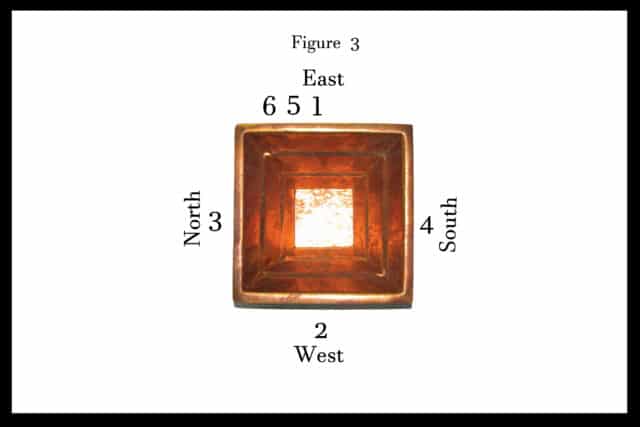
The rice remaining after offering balis should be thrown away and not consumed. If cooked rice is not available, small banana slices or some other fruit slices can be used. Again, any fruit pieces left over after Bali should be thrown away and not consumed.
17. వశోర్ధార (Stream of excellence)
Take a little ghee into the ladle and pour it slowly on the burning dry coconut pieces in the homa kundam while reading the third verse from “Rudra Chamakam”. It is given below. Don’t pour too much ghee if you don’t want much smoke. Just take one teaspoonful of ghee in the wooden ladle and manage with it slowly. This ghee should be just enough to make the pieces burn well so that poornaahuti (about to be offered) burns well.
ఓం శం చ| మే మయ|శ్చ మే ప్రియం చ| మేఽనుకామశ్చ| మే కామ|శ్చ మే సౌమనసశ్చ| మే భద్రం చ| మే శ్రేయ|శ్చ మే వస్య|శ్చ మే యశ|శ్చ మే భగ|శ్చ మే ద్రవి|ణం చ మే యంతా చ| మే ధర్తా చ| మే
క్షేమశ్చ| మే దృతి|శ్చ మే విశ్వం చ మే మహ|శ్చ మే సంవిచ్చ| మే జ్ఞాత్రం| చ మే సూశ్చ| మే ప్రసూశ్చ| మే సీరం| చ మే లయశ్చ| మఋతం చ| మేఽమృతం| చ మేఽయక్ష్మం చ మేఽనా|మయచ్చ మే
జీవాతు|శ్చ మే దీర్ఘాయుత్వం చ| మేఽనమిత్రం చ మేఽభ|యం చ మే సుగం చ| మే శయ|నం చ మే సూషా చ| మే సుదినం| చ మే||
18. పూర్ణాహుతి (Poornaahuti)
Now, we have to prepare a package for poornaahuti (“complete offering”). The normal procedure is to place a full dry coconut, some metal coins, some turmeric, some sandalwood, some kumkum, some akshatas, samples of some of the materials used in homam as offerings in a cloth and tie the cloth. For a simple homam with a small fire, you may take a dry coconut half and place a few akshatas, one coin, little sandalwood powder, turmeric powder, kumkum powder and samples of materials offered earlier in it. If you do a small homam everyday in a western country and need to minimize the smoke, you may put just a small coconut piece as poornaahuti. If you are doing homam in a big firepit that is dug in ground, you may want to experiment with a regular full coconut that has little water. It is a more accurate representation of the ego of a normal person. Place the poornaahuti on the wooden ladle, say the mantra below and then place the poornaahuti in fire carefully with hand (if you drop it on a small fire from the wooden ladle, it can extinguish the fire and also loose materials can spill everywhere in the homa kundam).
ఓం పూర్ణాహుతిము|త్తమాం జు|హోతి| సర్వం వై పూ||ర్ణాహుతిః| సర్వ|మేవాప్నో|తి| అథో| ఇయం వై పూ||ర్ణాహుతిః| అస్యామేవ ప్రతి|తిష్ఠతి|
ఓం పూర్ణమదః పూర్ణమిదం పూర్ణాత్పూర్ణముదచ్యతే| పూర్ణస్య పూర్ణమాదాయ పూర్ణమేవాశిష్యతే||
ఓం లక్ష్మీనారాయణే నమః| పూర్ణాహుతిం సమర్పయామి|
While (or after) placing the poornaahuti in the fire, say the following mantra
ఓం బ్రహ్మార్పణం బ్రహ్మహవిర్ బ్రహ్మాగ్నౌ బ్రహ్మణా హుతం| బ్రహ్మైవ తేన గంతవ్యం బ్రహ్మ కర్మ సమాధినా||
Imagine that you are completely surrendering yourself to Vishnu. Poornaahuti basically means “complete surrender”. The full (or half) coconut used in the poornaahuti is a symbol of one’s head, i.e. ego (“I-ness”), which is to be sacrificed (surrendered) to Vishnu. Think of Vishnu as a manifestation of the Supreme Cosmic Being who fills the whole universe and who is the true owner of your body, mind, existence, thoughts, knowledge and actions. Surrender to Him fully. Without that inner sense of complete surrender, an elaborate poornaahuti ritual with pristine materials has no meaning. Most Vedic rituals are symbolic of certain inner changes that you bring about within yourself, to remove obstacles within your sookshma sareera that are blocking self-knowledge. The purpose of Veda is the knowledge of self (Aatman) and all rituals are ultimately for that purpose. Doing rituals blindly is a good starting point, but at some stage, one has to wonder about the inner meaning.
19. అగ్ని పూజ మరియు ధ్యానం (Final prayer to Agni and Meditation)
The fire god (Agni) has carried all our offerings to various gods. So the final offering is to him. Read the following and offer a drop of ghee in the fire.
సప్త తే| అగ్నే సమిధః| సప్తజిహ్వాః సప్త ఋష|యస్సప్తః ధామ| ప్రియాణి|| సప్త హోత్రా| సప్త ధాత్వా యజన్తిసప్తయోనీరాపృ|ణస్వా ఘృతేన స్వాహా||| అగ్నయే సప్తవత ఇదం న మమ||
Take some water in a spoon and sprinkle it around the homa kumdam as shown in the following figure. This is similar to what we did at the beginning, but the mantras to say are slightly different. Instead of the four mantras used earlier, use the following four mantras when sprinkling water along the four arrows marked as 1, 2, 3, and 4 in Figure:
అదితేన్వ|మంస్థాః| (SOUTH)
అను|మతేఽన్వ|మంస్థాః| (WEST)
సర|స్వతేఽన్వ|మంస్థాః| (NORTH)
దేవ| సవితః ప్రాసా|వీః|(EAST)
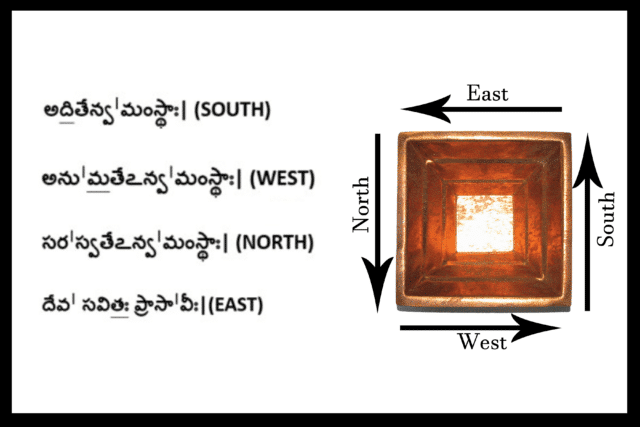
The ritual of homam cleanses one internally. The powerful divine presence in the fire has a great ability to cleanse one. Especially, a sincerely offered poornaahuti creates a lot of positive energy as it burns. One can take advantage of it by meditating in front of the fire as the poornaahuti burns. The time when the poornaahuti burn is the best time to meditate.
Sit still with a straight back in front of the fire and meditate. Make sure that the back is erect and yet not too tight. Make sure that the neck and head are also erect. Close the eyes, imagine your favorite deity in a form you like and meditate on that form with your favorite mantra. You can meditate on Vishnu also. It can be the mantra with which you did homam or any other mantra of any deity. Try to forget about the your body and what you are doing and get into the mantra fully. Think that the deity you are imagining is a manifestation of Supreme Cosmic Being and think that all beings and all objects of this world are expressions of the play of that deity. Think that that deity is the true Doer of all actions by all beings of this world. Your chances of losing consciousness of your body and immersing in the mantra fully are the maximum at this point of time than any other (while the poornaahuti is burning)! Take advantage and meditate for atleast 5-10 minutes with maximum focus now. Consider this an essential part of the homam.
20. రక్ష (Raksha)
Now, take the darbhas placed at the beginning outside the homa kundam on the western side (or new darbhas, if you did not place any darbhas along the boundaries due to lack of darbhas), apply a little ghee to them and place the tips in fire. When they catch fire, remove them from the fire, place them in a container and let the whole darbhas burn. The black ash you get is called “rakshaa” (protection). At the end of the homam, you can apply a little rakshaa to the forehead of the idol and then a little to your own forehead and the foreheads of others. This is believed to protect from evil forces. You can store the rakshaa for future use on important occasions. If your fire is too small and does not last till this point, you may consider taking rakshaa before meditation. It is not necessary to take raksha. One can skip this step. Alternately, one can skip now and later mix the ashes of the materials burnt in the homa kundam with ghee and use that as rakshaa.
21. ఉద్వాసన (Goodbye)
Take a couple of darbhas in your right hand and a couple more darbhas with your left hand. Take some flowers or akshatas also if available. Hold the darbhas with the tips facing away from you and the bases in your hands. Now touch the two sides of the homakundam with the darbhas in the two hands. Then touch the idol with those darbhas and leave the akshatas and flowers on the god. Imagine that the energy from the homakundam has been transferred into the idol. To simplify this, you can also place your fists containing a few akshatas on top of the northern and southern sides of homa kundam and then deposit the akshatas in those fists at the feet of the idol. Say the following and show your heart with your hands. Imagine that Sri Mahaganapathi has exited the fire and came back into your heart.
అస్మాదగ్నేః శ్రీమహాగణపతిం యథాస్థానం ప్రతిష్ఠాపయామి|
Say the following and show your heart with your hands. Imagine that Lord Vishnu and Goddess Lakhsmi has exited the fire and the idols and came back into your heart.
అస్మాన్ముర్తేశ్చ అగ్నేశ్చ శ్రీలక్ష్మీనారాయణ దేవతా యథాస్థానం ప్రతిష్ఠాపయామి|
Now, we have to say goodbye to the fire god too. Say the following and bow to the fire god.
అగ్నే నయ| సుపథా| రాయే అస్మాన్ విశ్వాని| దేవ వయునా|ని విద్వాన్| యుయోధ్య|స్మజ్జు|హురాణమేనో భూయిష్ఠాం| తే నమ| ఉక్తిం విధేమ| అగ్నయే నమః||
22. మంగళం (Conclusion)
Say the following three verses. Think of Krishna and imagine that you are not the doer and Krishna is the doer who is acting through you. While you do it, place a few akshatas on the tips of the ring and middle fingers of the right hand, place the palm on the small deposit bowl and wash it such that the water and akshatas are deposited in the deposit bowl.
మంత్రహీనం క్రియాహీనం భక్తిహీనం హుతాశన| యద్ధుతంతు మయా దేవ పరిపూర్ణం తదస్తుతే||
ప్రాయశ్చిత్తాన్యశేషాణి తపః కర్మాత్మకాని వై| యాని తేషామశేషాణాం శ్రీ కృష్ణస్మరణం పరం|| శ్రీ కృష్ణ కృష్ణ కృష్ణ|
కాయేన వాచా మనసేంద్రియైర్వా బుద్ధ్యాత్మనా వా ప్రకృతేః స్వభావాత్| కరోమి యద్యత్ సకలం పరస్మై నారాయణాయేతి సమర్పయామి||
Say the following finally. Imagine that Lord Vishnu and Goddess Lakshmi became pleased with your homam. Surrender the doership of the homam to Krishna and pray for peace.
అనేన దివ్య మంగళ హోమేన భవవాన్ సర్వాత్మకః మహావిష్ణుః ప్రీయతామ్ | ఓం తత్సత్| సర్వం శ్రీ కృష్ణార్పణమస్తు| ఓం శాంతిః శాంతిః శాంతిః|
After this, you should not think of yourself as the doer of the homam just finished, for you have surrendered the doership to Krishna! The naivedyam (food) you offered can be eaten now and served to others. The rakshaa (holy ash) can be mixed with a drop of ghee and applied on the forehead as a dot or a line. If you used a kalasam (water pot) in addition to an idol to invoke the god, you can take a bath with the water in the kalasam. Pour the water on yourself after you finish your bath, while saying a mantra of Vishnu. After pouring that water on yourself, don’t pour any more regular water. The water from kalasam should be the last water you pour on yourself in the bath. In other words, you should absorb the energy in that water for a while.

